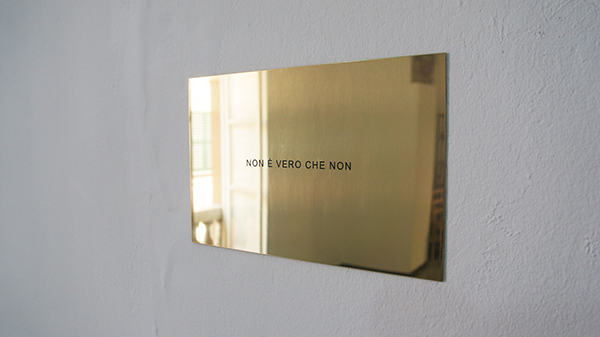Leggi l'articolo intero
IT IS NOT TRUE THAT IT ISN’T
One day Funes, the man with a prodigious memory, tested the extent of his abilities by writing down everything he remembered from the day before. His memory of these past moments was so precise that his undertaking took up the whole day. At the end of his tale, Borges tells us that Funes was not a happy man on account of his hyperactive memory, he was not happy because he could not think. That is because thinking means thinking as impotentiality, thinking as lack. Thought emerges as a negative, from an original negativity without which all cognitive exercise is impossible. Heidegger said something similar about states of mind like boredom or anguish, i.e. that it is only in this regressive existential condition where the world and time abandon us that we experience openness, Uebermacht, and we are able to philosophize.
Besides, as linguists explain, no thought can be said to be affirmative. On the contrary, language is a system of “differences without positive terms” (Saussure), it is the result of differential relations between the very terms of the relationship. A “complex of eternally negative differences”.
Even Nietzsche’s “yes” to life, the exact opposite of the donkey’s invariable “yes” (hee-haw, hee-haw) in Zarathustra, is the result of an impressive series of “nos”, of a tight deconstruction of the old values of Christian morality in a transvaluation of values for the Übermensch. The same we could say as concerns the alienation of the self/nature from an outside supported by the logic of reason, if we look back at the primal scene of Enlightenment positivism that Adorno recounts through the Odyssey. It is a bitter dialectic that is part of us, an exhausting resistance to the call of indistinct nature, the Lotus Eaters, the Sirens, the Cyclops, Circe, which tells us how human history started with a disclaimer, with a separation, with an act of denial of our (own) most natural characteristics. Ours is the history of this exodus.
The quest for the anthropological arche, the philosophical quest for the ultimate essence, for sheer life, the physics’ search for the particle that precedes Creation, the regression of the psyche or in art (Kafka, Artaud, Malevich, Duchamp, Cage), and, as it has been said, the very existence of language, are all expressions of this negativity.
In a nutshell, what the possibilities of a body-mind are, that is, what potential is, can only be surmised from the power to not act. Potential is always a potential of refusal. If I say “I cannot talk” this may mean I am experiencing a physical impediment, perhaps I am hoarse or have a sore throat, but it has nothing to do with potential. If, on the other hand, I say “I may not talk” I am freely expressing the power to say or do one thing rather than another. Potential is holding off, it is an anesthetized power, it is an impotence, it is inextricably connected with the power to not act, and its genetic code is “not”, negation.
Paolo Virno has long been researching the relationship between negation and possibility in its different modalities. In his essay And so on to infinity places this relationship, along with the infinite regression, at the core of all emotional frequencies that characterize our relationship with our environment and with others. The articulation between verbal thought in general and the perceptual-passionate world rests on these three logical categories, and these characterize the specificity of human nature: negation, namely the ability to say things as they are not, “you are not my mother”; the use of the expression “it is possible that”, as it reveals the lack of specialized instincts to cope with the environment and at the same time the creative plasticity with which we navigate contingency; the possibility that passions precipitate in an endless march backwards. These three devices that characterize our way of life are only possible from the point of view of negation.
In the last two decades, science has established a fact that we have indeed always known, i.e. that the human mind is biologically shaped to be a social mind. Mirror neurons are activated in the presence of the other, in imitation and empathy. If considered from a different vantage point, such scientific evidence – much publicized by the naturalistic determinism in support of the notion that nature provides for everything – in fact highlights that sociality, the inter-specific empathy ensured by the neuronal action, can be invalidated by negation. As history warns us especially as concerns wars, the recognition of the other may not happen at all. This is because language, which intervenes during the first years in the life of a child in the relationship of complete empathy with his/her mother, does not add to the we-centric space established by neurons. On the contrary, it hinders it and often erases it completely under the influence of negation: “You’re not a man.”
Negation has an amphibian nature: on the one hand it halts recognition of the other with sometimes catastrophic consequences, while on the other hand it appears as the only antidote to the lack of recognition, “it is not true that you are not a man”. Negation is language’s medication, the antidote for the poison that it injects itself in human communication. Under the influence of negation, language continuously tears apart and mends that fragile neuronal empathy, and what takes place in the public sphere is the ongoing outcome of this conflict.
Between negation and double negative as it is presented on this occasion there is difference, in the sense that negation, in its ambivalent nature of poison/antidote retains a dialectic with the negated object that can lead to a suspension of judgement: if I say “not black” I am not saying “white”, but opening up to an infinite series of colour shades that from black lead to white. Negation has this special foundation in that, in order to work, it needs to refer to the negated object and thus allow it the possibility of being different.
Thus negation, which reveals the power of language in the anthropogenetic process, as well as carrying the risk of a lack of recognition and being the driving force of any disobedience and any deviation from the norm, is also the device that can stop the conflict, postpone it to another time: not now. Not here.
In the specific case of It is not true that it isn’t, we should add that the pacifying suspension of dialectic is lost. It is erased by a substantial, ingrained notion that precedes it and unequivocally and utterly undemocratically informs the true meaning of the double negative: IT IS NOT TRUE THAT IT ISN’T possible to live without a king or a master.
.
Mauro Folci
Genova/july 2014
.
It is not true that it isn’t, 2008
(…) In the specific case of It is not true that it isn’t, we should add that the pacifying suspension of dialectic is lost. It is erased by a substantial, ingrained notion that precedes it and unequivocally and utterly undemocratically informs the true meaning of the double negative: IT IS NOT TRUE THAT IT ISN’T possible to live without a king or a master. (…)





